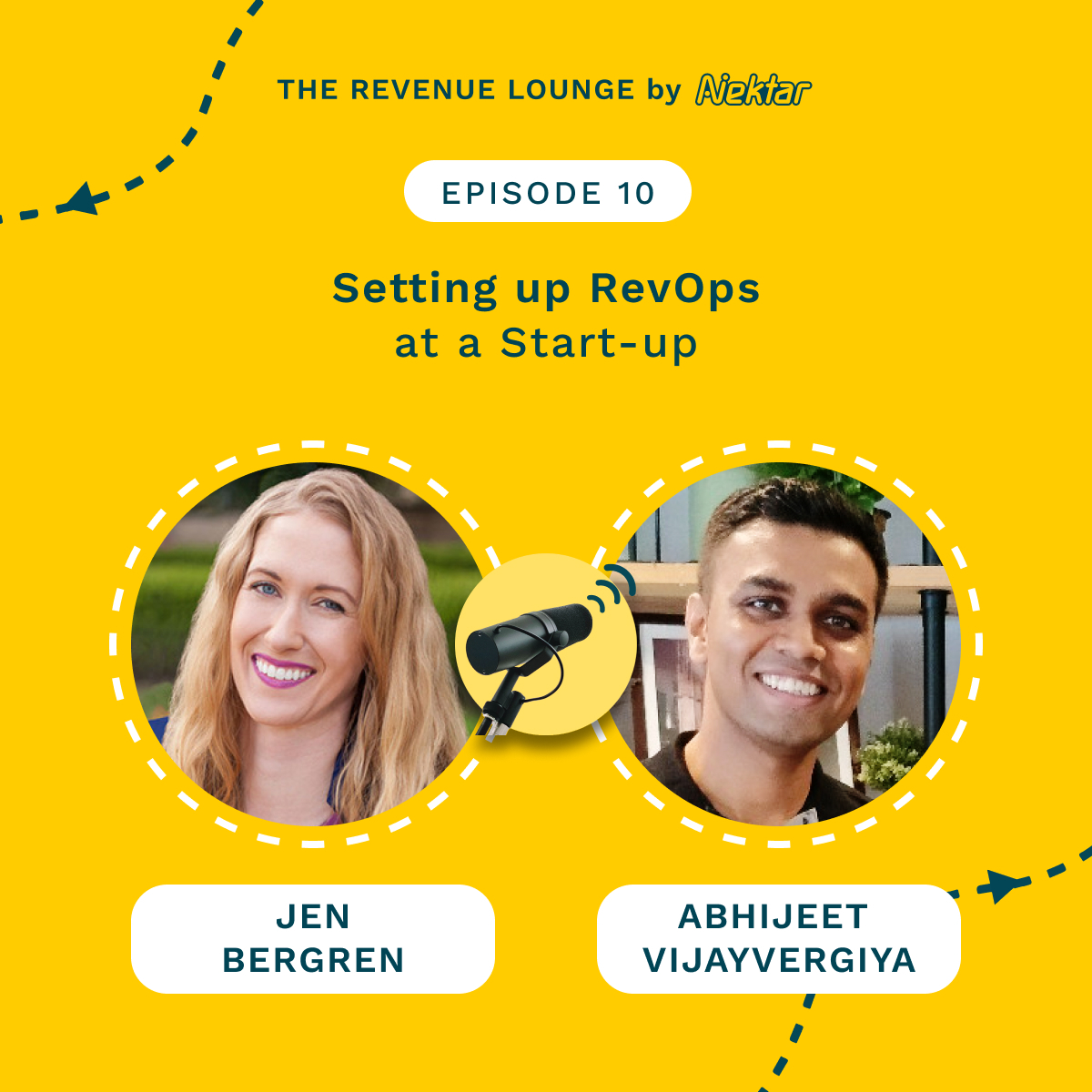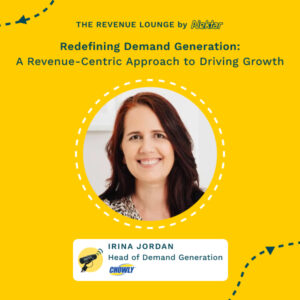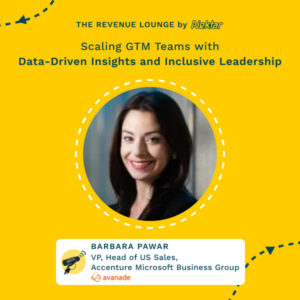Growth Without Borders: Scaling GTM in a Fully Remote Organization ft. Patrick MacKelvie
November 13, 2024
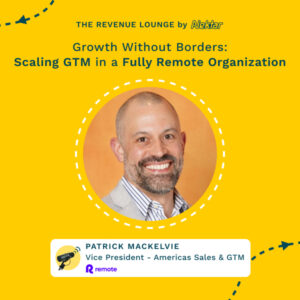
About
The Revenue Lounge
The podcast covers stories from leaders across RevOps, Sales, Customer Success, GTM, Data and Marketing about what drives these functions and what advice they would share with our listeners. With 3 seasons recorded, the podcast currently features 50+ enterprise leaders in the B2B SaaS domain. Tune in to hear from the best in the business
In this conversation, Randy Likas and Patrick MacKelvie discuss the evolution of remote work, particularly in sales leadership roles. They explore the challenges and opportunities presented by a fully remote environment, the importance of async communication, and the tools that facilitate productivity. Patrick shares insights from his experience at Cornerstone and how those lessons are applied at Remote, emphasizing the significance of investing in team members and maintaining effective communication. The discussion also touches on the value of face-to-face interactions and the evolving philosophies around virtual meetings. In this conversation, Patrick MacKelvie discusses the importance of regionalizing teams to enhance market understanding and collaboration. He emphasizes the need for effective onboarding processes in a remote work environment, including the use of an onboarding buddy system and coffee chats to foster connections. The discussion also touches on the challenges of securing attention in sales amidst a crowded market and the significance of cross-functional collaboration. Patrick shares personal insights on leadership, the importance of managing expectations, and the value of persistence in sales outreach.
Takeaways:
- Remote work can unlock unprecedented opportunities for productivity.
- Companies must adapt their go-to-market strategies for remote environments.
- Async communication is essential for efficiency in remote teams.
- Sales leadership requires a different approach in a distributed environment.
- Investing in team members is crucial for long-term success.
- Tools like Loom and Slack enhance communication and collaboration.
- Face-to-face interactions remain important for building relationships.
- Cameras should be on during meetings to enhance engagement.
- Balancing async and sync meetings is key to productivity.
- Learning from past experiences can guide future strategies. Regionalizing teams enhances market understanding and collaboration.
- Local events facilitate better team connections.
- Onboarding buddies help new employees navigate remote work culture.
- Setting expectations with stakeholders is crucial for success.
- Persistence in outreach is key to overcoming market noise.
- Cross-functional collaboration enriches team dynamics.
- Effective onboarding is structured yet flexible.
- Coffee chats maintain personal connections in remote settings.
- Understanding the broader business context improves sales effectiveness.
- Enjoying personal life balance is essential for long-term success.
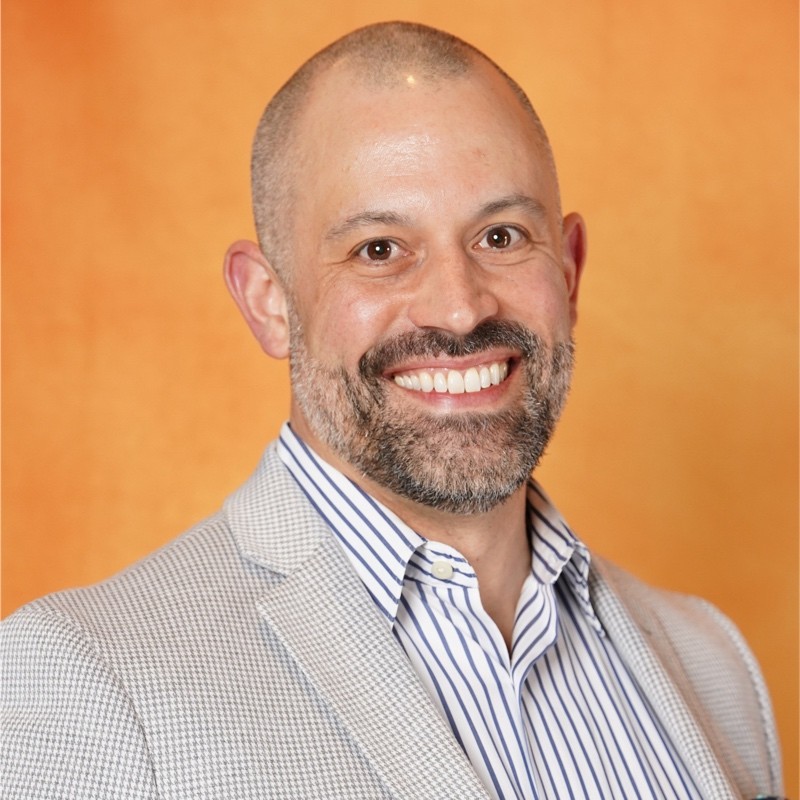
Randy Likas (00:02.296)
When COVID broke out in the U.S. four and a half years ago, everyone was forced into an environment of change and uncertainty. Remote work for nearly everyone became the norm. A key learning though, and one of the benefits was that remote work can unlock unprecedented opportunities for productivity, work-life balance, and efficiency. And it also proved that operations could be scaled globally. Yet it brings its own set of challenges, especially when it comes to aligning teams, driving growth, and expanding into new markets.
In a fully remote organization, the rules of engagement are different. While many companies are calling for people to come back into the office, hybrid work has become the norm. And many organizations have adopted a remote work environment. So how do companies scale their go-to-market strategies effectively in this new paradigm? Hello, everyone. Welcome to the Revenue Lounge podcast. I am your host, Randy Likus. And in today’s episode, we will dive into the intricacies of scaling a global go-to-market strategy within a fully remote organization.
Joining us as we explore how remote first organizations are rewriting the playbook for global expansion is Patrick McKelvey. Patrick is the vice president of Americas for Sales and Go-To-Market at Remote. Prior to Remote, he was the VP of Commercial Sales at Cornerstone On Demand. Patrick, thanks so much for joining us today.
Patrick MacKelvie (01:18.934)
My pleasure, Randy. Glad to be here.
Randy Likas (01:21.11)
Yeah, I’m happy to have you here as well. It’s a topic that I think is kind of on everyone’s minds, especially as people are calling for people to come back into the office. But you and I both work at fully remote organizations, and so I think we’re having a great discussion. We’d love to just sort of kick things off and have you tell us a little bit about yourself and your current role at remote.
Patrick MacKelvie (01:44.12)
Yeah, sure, happy to. So I’m based in Portland, Oregon, but as you mentioned, we’re a fully remote company, fully async, so no offices of any kind. my office is what you’re looking at back here, which is a beautiful thing. Married, I have a lovely six-year-old daughter who keeps us really busy. Love to spend a lot of time when I’m not selling or chasing salespeople around. We’re doing outdoor activities, living in the beautiful Pacific Northwest. And then work-wise, yeah, I’ve been a…
you know, a lifelong sort of sales professional and talent developer, I like to say, I think the two things are, you know, two sides of the same coin. I actually started my career as a, as a teacher. So I think there’s a lot of parallels with, with sales and especially sales leadership and developing people, mentoring people, which is, you know, other than making money and helping other people make money, what I love the most about my job.
Randy Likas (02:33.41)
Great. And so you lead the sales and go to market currently. Tell us a little more about that. How big of a team do you have? And just a little more about the sales organization.
Patrick MacKelvie (02:47.124)
Yeah, sure. So remote, you know, we’re, headquartered in San Francisco on paper, but like I said, we’re a fully remote and distributed organization really started, you know, company launched actually going out through the European market, kind of the greater EMEA region, really in the employer of record space EOR for those familiar. America’s had been kind of a, you know, a emerging market for us, if you will. And eventuality ultimately is kind of the biggest, you know, white collar tech economy in the world still.
But yeah, I was hired to basically take a lot of the great things that were happening in EMEA and figure out how to parlay that into success in the greater Americas. So currently we lead a team of 55 individual contributors, a host of managers and supporting roles, sales development, marketing adjacent, rev ops adjacent, a lot of the supporting roles that I don’t manage directly, but certainly coordinate with leaders on the team to make sure that we’ve got a fully aligned go to
team and motion here in the United
Randy Likas (03:47.64)
Great. And do you all have like, is your team segmented out? Like, do you go after like SMB and Market Enterprise or is, you kind of your business skew in a specific area?
Patrick MacKelvie (04:01.464)
Yeah, so it’s split up in a couple of different ways. So we are segmented, we do designate between S &B and what we call mid-market plus. So kind of organizations that are roughly 500 employees and over is sort of the off-market segment for us. And are doing some analysis right now on actually segmenting those roles further and really just sort of identifying how our clients buy essentially and looking at sort of more transactional volume business, know, largely in-batch.
kind of quicker close that sort of thing versus more strategic business. And we find both of those motions exist within SMB. And then we also have specific product motions around our employer record product, our contractor management product, our global payroll.
Randy Likas (04:43.704)
And then does your team also skin with the kill, right? Or do you pass the business back over to a customer success team after the accounts landed?
Patrick MacKelvie (04:56.202)
Yeah, so we have a designated account management team on the other side of the book. Historically, when remote was growing, we were kind of hunter farmers. We called it ranchers, which was a new term to me. But I like that. It kind of makes sense. Now we’re totally segmented on the other side of line with the account execs on the hunter side and the account managers.
Randy Likas (05:15.682)
Yeah, fantastic. All so let’s kind of dig in a little bit about the fully remote organization, right? That’s what you guys are at remote. And so with no physical office and having a team that’s distributed across the US, can you talk to me a little bit about how you approach Sal’s leadership with your team members in sort of this distributed environment, lot of async communications, and what your thoughts are on that?
Patrick MacKelvie (05:46.838)
Yeah, and we, for clarity, we’ve got folks in US, Canada and actually throughout Latin America as well. definitely across the, mostly in North America. We’ve got a few folks down in Central and South America as well. Yeah, the remote environment’s interesting. And I think like for someone like me, I think for a lot of folks, you we’ve been remote for a good period of time before it was sort of forced upon us with COVID and all the, you know, sort of resulting changes from that experience. But.
It’s really the async environment that’s interesting. And to work for a company that was founded by engineers with really an async ethos, that’s been an interesting kind of dichotomy and almost like a marriage between those of us who are in prospect or customer facing roles that really need to be online when the people that we need to talk to are online, right? So we can’t be fully async, but embrace a lot of async philosophy. So there’s a lot of documentation. are maybe Slack’s poster child. We use Slack.
almost religiously, some other tech to actually put everything in documents, make those documents shareable. And we really just try to streamline from an efficiency perspective, really everything that we do. So it’s actually really nice. It’s a nice sort of step forward, I feel like, from just a remote environment into more of an async environment. It really gives us some pretty big gains for efficiency. And examples of that, a lot of the policies and the things like that obviously are documented, and you can kind of read those in your own time.
things that don’t need to be done in a truly live environment. But a lot of our supporting roles are actually positioned around the globe as well. So if we need feedback on a legal contract, maybe we’re negotiated or something, a lot of those things can actually be put in place or in a queue when we sign off in the evening on the America’s time zones, get some of those things like processed or progressed overnight, and then kind of have those things ready to rock and roll when we wake up in the morning and sit down at our desk with our coffee.
Randy Likas (07:41.24)
Yeah, so at Nectar, we’re a full remote organization as well. We’re headquartered out of Singapore. And so what you just said is completely rings a bell with me, which is, know, we’re kind of around the clock, right? You have something going on, you bring it over, and by the time you wake up, you’ve got your answers to some questions. So absolutely. So let’s go back a couple of years. So four and a half years ago, it March of 2020, COVID breaks out. You were at Cornerstone at the time.
Quarterstone, I assume at the time was, you guys worked out offices, is that correct?
Patrick MacKelvie (08:10.434)
Mm-hmm.
Patrick MacKelvie (08:16.6)
Yeah, so we had a corporate headquarters in Santa Monica and then number of San Monica California that is and then a number of offices around the world. But yeah, there were a lot of the sales function and some other other folks on the go-to-market side who were remote based. But definitely still sort of came into the mothership with some regularity, right?
Randy Likas (08:33.654)
Yeah. So what was that like? So March came around and most businesses started shutting down, or at least everyone was sort of mandatory, working remotely, what was that change like for you all, and how did you manage that?
Patrick MacKelvie (08:50.23)
Yeah, I think the biggest pivot for us, Cornerstone had and still has a very strong corporate culture. And so, you know, we used call it kind of corporate Disneyland when you go to Santa Monica and there’s ping pong tables and refreshments and all the things that you’ve experienced, kind of that big tech stuff. know, a lot of that was just great. And so I think it was a lot more disruptive for people who are used to coming into the office and working under those pretenses than someone like me who was largely remote based. For myself and my team, know, field sales team.
I think the biggest shift was just not traveling and actually having to pivot the way that we conducted business when kind of this remote lifestyle was forced upon us. you know, there’s so much you can learn anybody who’s been in a, you know, big pitch meeting or, you know, kind of a closing meeting or an onsite demo, you know, that there’s so much that you can, you know, pick up just being in the room and looking at body language and chatting with people, you know, conversation before the meeting starts, after the meeting starts, those sorts of things. So to completely shift away from that and interacting, you know, exclusively like this, I think we all had to become a lot.
Our senses had to become a lot more acute because we weren’t able to work off a lot of those cues. then, you just being home, lot of the, there were so many videos and memes and stuff about, I was thinking about the guy who was like on CNN and his kids running around in the background in his office. think adjusting to a lot of that was challenging for us. But, you know, we got through it. We were all in it together, but definitely a big departure from the norm and a big shift.
Randy Likas (10:11.308)
Yeah, and I think that was pretty much consistent with a lot of companies. was a lot of people were nervous, right? Like what’s gonna happen to our pipeline? What’s gonna happen if you have people that we can’t sort of look over people. And I think there were just a lot of surprises that like business certainly can be done in this environment. lots of companies grew in that period. And it’s funny because now we’re at a point where people…
Patrick MacKelvie (10:22.294)
Thank
Randy Likas (10:36.542)
have gotten used to it, they enjoy it. They don’t have to travel an hour and a half, two hours back and forth. And a lot of companies are trying to get their people to come back in full time. It’s not really going over too well. And so you see a lot of this sort of hybrid coming in for a few days. But I think remote work is here to stay in some capacity or fashion, right?
You mentioned though, and I find it interesting because we’ve kind of gotten four and a half years later used to this environment on the sale side. often, I’ve found it sometimes a little bit more difficult when we get back on the road and we want to have these face-to-face meetings and pick up on these queues that.
people are like, well, you’re gonna be a talent, great, but I’m not gonna be coming in the office, right? And I live 45 minutes away. So it’s, from a sales perspective, it’s kind of changed our way in terms of how we travel. Sometimes we’re going and meeting people for coffee closer to where they live, as opposed to like where the corporate headquarters is. And so, are you kind of finding that same thing?
Patrick MacKelvie (11:24.371)
Yeah.
Patrick MacKelvie (11:39.2)
Yeah, you know, the number of onsite, I mean, I think the expectation has shifted to your point. So a lot of meetings that would have been, you know, sort of in person first, or that would have been the default option, I think have shifted to more of a remote first environment. And so it’s certainly conducive to what we do and some of the flexibility that we try to empower not only for our own employees at remote, but also, you know, in the products and ultimately the service that we sell to facilitate more of that, you know, like remote async environment as well. And the idea is really just being able to
the best talent wherever it resides in the world, right? Why let physical proximity be barriers? So I think we try to kind of embody what we espouse with the way that we conduct our business as well. And it’s almost like you appreciate it when you do get to go on site. It’s trade show season here, at least in the US, North America. And so it’s been fun to actually meet some of my team members for the first time after being here for almost eight months and see how tall they are in real life and some of those things.
Randy Likas (12:24.664)
100%. Yeah.
Randy Likas (12:38.198)
Yeah.
Patrick MacKelvie (12:38.444)
Definitely don’t take it for granted anymore, but I wouldn’t trade it. I’ve gotten to see my six-year-old daughter grow up, basically, and that’s a reality that were it not for COVID and some of the ways the world changed, I probably would have missed some pretty big and significant chunks of that.
Randy Likas (12:53.196)
Yeah, that is one of the advantages and kind goes back to that point of like work-life balance. You are able to do a lot of things that you weren’t able to do before. I’ve often, also it makes me appreciate when we do have the face-to-face because people just open up more, you can probably accomplish more over a 60 minute meeting in person than you can through five or 10 Zoom meetings, right? In terms of what you’re learning and what people are sharing. So while remote work is here to stay,
You know, I think just getting back out and seeing customers and interacting with them, especially for, you know, a go-to-market person is extremely important. Are you all encouraging that as well, going out and seeing customers?
Patrick MacKelvie (13:36.184)
Yeah, I mean, we certainly don’t discourage it. think, you know, there’s some efficiencies that can be gained, but it’s really pivotal to get out on the road and, you know, spend some face time with folks. doing that. What we are doing a lot more deliberately is getting out and doing regional events or side events, you know, in conjunction with bigger conferences. And so that’s been a way to kind of, you know, do a little bit of that without like fully course correcting and going back to our, you know, sort of pre-COVID reality.
We are doing some things like remote’s never had an in-person sales kickoff, revenue kickoff. So in January, we’re gonna do that for the first time, bring the whole team together, which is pretty awesome. So for an old sales dog like me that values that face-to-face interaction, it’s a breath of fresh air, but not too much.
Randy Likas (14:20.226)
Yeah. Now that’s great. So let’s talk about your experience that you had at Cornerstone, because you were there for what? Almost 11 years. And you grew really, really quickly at tons of revenue. What are some of the learnings you took from Cornerstone that you’re bringing over now to remote, where to your point earlier, you’re building a new market here in the Americas. And so what are some of those learnings that you’re trying to reapply rather than reinvent the wheel?
Patrick MacKelvie (14:46.699)
Yeah.
Patrick MacKelvie (14:51.704)
Yeah, good question. question. So, you know, I was at Cornerstone, obviously, US founded, went after the US market first and then expanded globally. So I was there early enough. I wasn’t there in the early, early days, but like putting together desks and stuff and whatnot. I came in, I think it was like employee 700 and something and now they’re like 6,000. So it gives you some sense of scale, but I got to see that like indirectly, you know, kind of at a ringside seat, front row seat to Cornerstone’s international expansion. there’s a gentleman.
Vincent Beliveau is still there today as the chief international officer who really launched EMEA. And I remember seeing him in the early days, like advocate for resources and kind of, you know, kind of campaign and lobby for support and the things he needed. and didn’t know, you know, that someday I would be doing that basically in reverse, as I mentioned earlier with remote starting, you know, largely in Europe and expanding the U S but definitely some passive takeaways. You know, I’m kind of like, yeah, I remember when Vincent was talking about that or doing that and, and credit to him because now
that their presence in EMEA and really around the world is enormous. And that was basically all on the back of a lot of the groundwork that he laid. certainly some of that. then culturally at Cornerstone, being, for those who don’t know, a learning management software, now kind of a talent management provider, and have expanded beyond learning into some other aspects of talent management. But one of the things I always really appreciated, especially with Matt Brown as a teacher, is they were so committed in developing their own people.
So not only developing markets and capacities and whatnot, but really leaning in and saying, Hey, how do we maximize the skills, desires, some of the opportunities that we have in house, everybody with the team that we have on the staff, you know, on the current in the current org and obviously fill in, you know, sort of gaps beyond that with folks from outside the org. But that’s what their software did. And they really just call it like our internal version of course, then we use this called dog food, like eating your own dog food sort of thing.
I would have rather been champagne, drinking your own champagne. It’s a better than dog food. But that really stuck with me too. And it’s something that a lot of people invested in me and gave me a ton of opportunity to take steps forward in my career for which I’ll be forever grateful. But trying to play that forward when I was there, it’s certainly something I’ve carried with me to remote and will for the rest of my career. I just think it’s so important to invest in your own people and a lot of times some of the talent for the job you’re trying to fill or the task.
Randy Likas (16:43.906)
Yeah.
Patrick MacKelvie (17:12.024)
you’re trying to accomplish is actually right under your nose.
Randy Likas (17:15.522)
Yeah. Do you find, so now being at a fully remote company and having your team distributed all over, you’ve got probably some pretty aggressive growth targets that you’re trying to hit and people are managing sort of their own book of business. What’s your operational cadence look like maybe with your direct reports and then their teams to make sure that you’re pacing to the forecast and is it daily, is it weekly? And is it different maybe
at remote compared to how it was at Cornerstone.
Patrick MacKelvie (17:52.128)
Yeah, I think, you know, there’s definitely more of a tendency to not accomplish something with a sync meeting that could be accomplished async. And that’s, that’s something that is really clear from Marcelo LeBray, you know, Vanderbort, our founders at Remote, and something they fundamentally believe in. It’s like a non-negotiable in their mind. So I mentioned earlier, we kind of have to balance that with these prospect and client-facing roles that we sit in. But as far as our teams go, you know, we do have sync meetings. I’ve moved a lot of my syncs with my leaders to be bi-weekly. And then,
one-on-ones we just use, we use a platform called Notion. And for those who don’t know, it’s kind of like a, I don’t know if they’d appreciate me saying this, but it’s like a Google Docs on steroids. like a much more capable Google Docs. we, everything is in there. Like you can go to our website and our employee handbook is in Notion, public facing, you know, so we like everything has a Notion page. It’s kind of a joke, but it’s also a truth. So a lot of it is just prepping a lot of that information and really, really emphasizing the importance of pre-reads before we get into a meeting. So it’s like something that may have taken an hour.
in my former life or in former roles, we can actually accomplish in 15 or 20 minutes if everybody actually kind of does their homework, right? Does the pre-reads and we go from there. And so there’s a lot of async collaboration that feeds into the efficiency at the same time, if that makes sense.
Randy Likas (19:04.93)
Yeah, it does. What about like, so Notion is a key tool, a key tool. What about, you know, other forms of like go-to-market data that you need, you know, I’m not sure if you guys use Salesforce or not as your CRM, but, you know, I would imagine, you know, there’s other tools, sales tech tools, conversational intelligence tools, or other types of things that, you know, sort of help support and embrace, you know, the sort of distributed team.
what have you found to be sort of most helpful? And then that’d be, guess, you know, question one A. And question one B would be like, how do you make sure that the right data is getting into the right system so that you’re, you know, able to make effective decisions off the data?
Patrick MacKelvie (19:55.114)
Yeah, for sure. So like general collaboration tools, mentioned Slack. So we use a of Slack. It’s like round the clock because we’ve got a global workforce. And so I’ve actually had to like turn off the notifications on my smartwatch because like my hand was getting tired from vibrating, know, vibrating all day. There’s truth in jest actually. That’s, that’s, there’s, there’s more truth to that than you know. Another technology that I was aware of, but had not used before I came to remote is Loom. So just a video capture tool, you know, just kind of short videos. I mean, you can record longer videos as well.
Like when I provide forecasts, when my team forecasts to me, when I provide forecast updates to our C-suite, we do a lot of that via Loom. So we’ll do kind of a written forecast in Notion or sometimes in Slack, just depending on how formal it is and a Loom accompanying it and explaining it. And I think you don’t have to ask them, but I think with a lot of our, we call our executive team, the bridge is a little Star Trek reference. Our founders are big Trekkies, but the bridge team, most of them probably just watch that Loom and never actually read the document.
because it’s pretty comprehensive. get what they need to know out of that. So again, it’s about efficiency. So that’s big. And a lot of times it’s like a stream of consciousness. I can record a two minute, three minute video and probably save us both. I think actually Lume even says it on, have like a little tracker that says you’ve saved your team 16 hours of meetings and by all the limbs you’ve recorded or whatever. that’s a pretty great technology. Sales Tech Stack, we do use Salesforce.
We use Clary. One thing I call out to is we use Clary’s co-pilot functionality to record calls. And so we use that a lot for internal development coaching purposes. I’ve used Gong in prior lives for folks who are more familiar with that and not advocating for one tool over the other necessarily. But that’s huge for us too, I think in your passive time. And I still try to make time every week to listen to at least an hour of calls just randomly. So if my team’s listening to this, you may be on the wheel of rotation.
But it’s super insightful for me because I can’t be on every, it just doesn’t, I mean, it doesn’t scale. I would try to be on every sales call that goes on, but it gives me some good like passive insight into what’s going on. And some of the analytics, the tools like those have to kind of prioritize folks who are talking too much or not spending enough time asking questions and not asking the right questions. find that data and aggregate really helpful at my level as well.
Randy Likas (22:14.745)
Yeah. know, I found like Loom is it, we use Loom as well. It’s a great tool. Obviously when you’re talking to prospects and customers, but to your point, like I use it a lot internally as well. Like when I’m trying to just explain something really simple, it saves so much time to be like, here’s kind of what, rather than a 30 minute call, like a two minute Loom can accomplish the same thing. So a hundred percent agree with that. Are you finding, yeah. No, no, no, please, please.
Patrick MacKelvie (22:37.836)
for sure, and walking people through things, right? Like it’s, I’m sorry, go ahead.
Patrick MacKelvie (22:46.936)
Yeah, I was just going to say walking people through things and for those who have not used it just to be able to do a quick video, kind of have your face down in the corner so there’s a personal element to it. But to walk someone through a forecast or a report or something, it’s amazing how much efficiency you gain just by being able to, it’s like doing it live but not live if that makes sense.
Randy Likas (23:09.939)
Yeah, exactly. 100%. What’s your take? It’s funny. It’s sort of a philosophical debate that people have where you jump on these Zoom calls and people have the camera off. And some people are like, no, no, you’re talking to a customer. You’ve got to your camera on. And other people are like, well, just follow what the client does. If the client has it off, it’s OK for you to have it off, right? What’s your position on that?
Patrick MacKelvie (23:25.676)
Mm.
Patrick MacKelvie (23:36.95)
You know, I think this, would say my position has changed and part of it is going, think, fully remote and mostly async. I’m a big proponent in having cameras on and I think it’s as much for me, like selfishly, as it is for folks on the other side or whatever we’re trying to convey, just because I’m a people person, I’m a sales guy, right? So like I miss that, that human interaction. So there’s something to be said to sit here and see your face and facial expressions when I may not leave my office all day, right? Like I may, you know.
be walking around in my slippers all day, maybe go out to the kitchen to refill the coffee cup or something. But I really like it. And we, it’s not like a hard and fast requirement for us, but we coach our teams to kind of lead and set that example. And I also think you miss, we were talking about this earlier with the, you’re talking about moving, you know, online versus in-person, virtual versus in-person meetings. I think you miss out a lot as as a rapper, we’re trying to, you know, read, body language and the inference and that sort of thing. You have a camera off. think it.
in some way at least hamstrings us a little bit from what we might otherwise glean from being able to see somebody’s body language and that sort of
Randy Likas (24:42.444)
Yeah, no, I 100 % agree with that. Do you find yourself so, know, back in, I guess we’ll call pre-COVID, a lot of times, you know, leaders would be like, I’m gonna come out to Chicago for three days, like line up a set of meetings for me while you’re out there and, you know, kind of do ride-alongs or, know, team dinners, like that type of thing. Are you doing that still or?
Patrick MacKelvie (25:01.88)
Thank
Randy Likas (25:08.184)
predominantly are you working out of your own cities and using tools like Zoom?
Patrick MacKelvie (25:15.702)
Yeah, so we’ve, one of the things that I did when I came in and kind of took over the Americas, took the helm, I guess, is you regionalize the teams for the first time. And there’s a couple of reasons for doing that. One is, you know, we want to build capacity at every market, right? Make sure that we’re covering our territories and kind of owning the geos, like running them like franchises, all those sorts of things. But also by localizing, I gives us better perspective on what’s going on in the market and also better proximity to.
what’s going on in the market. So when there is a regional event or something that’s going on situationally, number one, not only are we more likely to know about it, but it’s easier for us to attend or cost effective for us to attend. And so a lot of the internal meetings that we have are bolted onto a regional event or a conference that maybe it’s a national conference that happens to be in that region. But ultimately, we’re not fully regionalized yet. I think we’ll get there at some point.
But ultimately that would be the idea and allows people, you know, just makes it more conducive to connect. One thing remote does too is we actually allocate budget for, you know, local sort of pods of employees within a city to get together. So we’ll, you know, pay for a dinner or a top golf or whatever, whatever folks want to do just to facilitate that. Cause there is an acknowledgement no matter how, you know, how passionate we are about remote, remote work and remote life and async life. You know, there’s an acknowledgement that it is great for people to get together sometimes sort of at their
Randy Likas (26:40.342)
Yeah. We talked about this a little bit earlier about the advantage of maybe cross-functional teams and having people overseas work on things while you’re sleeping. But when you think about other areas where maybe you have to actually sync with them during maybe the US hours and how we found maybe best practices around a fully remote organization to work with those cross-functional teams.
Any advice or recommendations you’d give?
Patrick MacKelvie (27:15.274)
Yeah, I mean, there’s certain things like, again, being in sales, we’re coming down to end of quarter or something and deals absolutely have to get done. And, you know, the resource is sitting in, you know, some, sometimes on over in, in Asia or something. It’s not super conducive or respectful to ask them to stay up or wake up in the middle of the night to, you know, see if we got those red lines back over to them whatever. So there have been situations where we built capacity, right. In our, in our region, just for practical purposes. So deal desk, legal, you know, rev ops support, things like that. And I’m grateful to
Randy Likas (27:43.468)
Yeah.
Patrick MacKelvie (27:45.9)
you know, to have that level of support. But we do, even then, like my partner in the rev ops org lives in Brazil. So, you he’s not, you know, he’s not a town away or even in my time zone necessarily, but it’s close enough and we were able to find an amazing, know, talented guy, Shadow from Gabriel, you ever listen to this, great, great for free brother. You know, it’s living, you know, almost, you know, half and rolled away basically. So.
There are those aspects as well. And then the other thing I would say, and we really coach the teams on this, and I think it’s best practice even if you work in a fully-sink culture, is to give people a heads up or sort of run way to get things done for you. It’s super impractical for a rep to bring a deal to the table like, you know, 5 p.m. on the last day of the quarter and say, I’m going to light the world on fire and you’re legal to come in and review these red lines. So we try to get out in front of that as much as we can and say, hey, legal team, you we’ve got these six contracts that are
going to need some attention so you know we’ll communicate with you we’ll slap you whatever you know kind of give us your you know give us your working hours or your bandwidth or whatever just so that it’s not a surprise I think that’s probably the biggest thing and we’ve all been there I mean I’ve been that guy you know probably more times than I can count so sometimes you learn the hard way but yeah I just think setting those expectations with folks and you know generally people are super supportive and willing to lean in and help you get things done especially at remote we’ve got an awesome
culture of folks around that who are really committed to helping sales be successful which I’m super grateful for.
Randy Likas (29:14.84)
Yeah, you bring up a really good point, and I’ll say it a little bit differently, but I think we’re saying the same thing is, got the importance of managing expectations with those other stakeholders, as opposed to sort of dropping it down at the last minute is critically important, you know, in a remote environment. And so you’ll get getting ahead of that. And of course, there’s always going to be.
last minute things where you need some help, but the surefire way to sort of burn a relationship is to dump a bunch of work on somebody when they’re not expecting it and ask them to turn it around the next day, right? So, yeah, I think that’s a really good point and is making sure we’re managing expectations and getting in front of as much as possible. What about onboarding? So, you you talked about America’s being sort of a growth market. And so I’m sure over the past nine months, you’ve been building out a team probably at a pretty rapid clip.
Patrick MacKelvie (29:45.794)
Okay.
Randy Likas (30:06.52)
You bring somebody on new to the organization. Yeah, you’ve got the tools internally, notion, know, whatever documents you have, a co-pilot to maybe listen to calls. But how do you make sure that you’re ramping new people effectively in a fully remote work environment?
Patrick MacKelvie (30:25.856)
Yeah, great question. we like most companies, maybe all companies have an onboarding curriculum and it’s very structured and kind of a week of getting remote and we put them into sales onboarding and product certifications and things like that. The two things that stand out though that I think are unique about remote, not entirely unique to remote, but two things that I think are somewhat unique or people might find unique is we have an onboarding buddy system and everybody gets an onboarding buddy. So when I started, I was paired with our VP of strategic finance.
who’s still a great friend and advocate. I’m very grateful for her and for having that relationship when we need to get things done with finance, super strategic. it’s very important because especially with all the notion docs and the Slack channels and just the async thing, and for somebody who’s coming maybe from a sync environment to async, I think just learning some of the cultural norms, it’s really important to able to bounce that off somebody for me to say, hey, Randy, this is kind of freaking me out. What’s going on with this?
You know, know this is a notion somewhere, but I just spent 20 minutes looking for it I can’t find it. Can you point me in the right direction before I, you know, before I go crazy? so that’s really important. The other thing too, and I think I actually don’t know the pedigree on this, but I’m pretty sure it started with our founders is, the openness and encouragement to set up like a 20 minute, they call them coffee chat, coffee chats. And they’re, know, totally virtual. Obviously, that maybe you, bring, bring your cup of coffee, your respective cup of coffee to the meeting.
Randy Likas (31:29.314)
Yeah.
Patrick MacKelvie (31:48.372)
And it’s sort of important culturally that you accept those. so I have, know, on any given week, I may have five or six people that I don’t know from across the company. Maybe they’re new, maybe they’re not. Reach out and just put time on my calendar because they’ve got some questions. And sometimes it’s as simple as, know, what do you like to do with this and that? But a lot of times there are business related questions and perspective that people are trying to get. And I think that is a great way to, you know, interact and kind of keep that personal aspect even in a remote world.
Also, you can get information transferred efficiently, kind of get some of those questions answered that may otherwise be sort of hard to find or somewhat nebulous.
Randy Likas (32:25.27)
Yeah, are you finding even after about nine months that you’re still doing those coffee chats as well?
Patrick MacKelvie (32:31.692)
do, yeah, especially when there’s somebody new in the org and we are growing so quickly in all, not just sales and go to market roles, but growing quickly everywhere. And so it’s amazing to me sometimes, like I recently did this with our partnerships team. We’ve got a really robust partnerships org and I talked to the leaders, but I didn’t talk to a lot of the kind of individual contributors and folks that were running different segments of the business. So it’s kind of like when you read a book and it sort of like opens your eyes to something, it’s some new topic or.
you know, sort of, sort of forum. And so you read a couple more books in that vein. feel, I feel like it’s sort of like that where I’m like, I’m kind of, I’m keen on this whole partnerships thing. Let me dig into this a little more. I feel the same way about like our, our business in Asia Pacific, you know, they’re, they’re also an emerging team. So interacting with them, you know, we have a lot of the same challenges and we’re focused on a lot of the same things, just solving for the same problems. And, know, like field marketing, for example, is something we’ve been bouncing back and forth and the markets are different and cultures are different and those sorts of things. But at the root, a lot of times.
there’s a ton of value in finding out what they’re doing, what’s working, what’s not, that we can leverage and hopefully share some of our own wisdom as well.
Randy Likas (33:34.37)
Yeah. You know, I’ve got one more question for you on remote. And then I’d be remiss if I didn’t ask you a couple, you know, go-to-market questions specifically before we kind of move over to our lightning round. So last question on remote. What haven’t I asked you that maybe I should have as it relates to, you know, working in a fully remote environment, scaling a go-to-market team, you know, in that type of a distributed environment that I, you know, like said, that I should have asked you.
Patrick MacKelvie (33:46.402)
Sure.
Patrick MacKelvie (34:07.87)
that’s a great one. think, you know, generally for anybody who is, you know, building a team, large organization, small organization, it’s actually the non-sales pieces that I find like the most insightful. I think you take on more responsibility and you can come up with a sales pedigree. And I’m sure this is true if you come up in, you know, in marketing or in finance or whatever, but it’s the cross-functional collaboration pieces and like what, you know, almost like the things that I didn’t know when I
in the door and in some ways are still learning. So I don’t know, I would say it’s a question you miss, but that’s been a big epiphany here at Remote. And while I don’t own marketing, it’s like being able to ask the right questions or understanding in a growing org versus cornerstone where we’ve had 6,000 people and it’s like every box has been checked, every question has been answered multiple times over. Just learning some of the nuances of the surrounding and supporting business. And I’d recommend anybody do that.
level you’re at or what size of organization, I just think it’s super healthy to kind of learn how, you know, be curious, I guess, and learn how sort of the machine, all the parts sort of fit together in the machine. I think it makes me better at my job and build some cross, you know, kind of cross functional collaboration amongst those different teams. so yeah, I think that’s, that’s been one, you know, kind of epiphany for me and, you know, and other things, yeah, think SDRs and partnerships and the list goes on and on because there are a lot of different orgs that interact with and ultimately support.
you to support sales orgs.
Randy Likas (35:35.416)
Yeah, great advice. So the Go Market question I had for you, I’ve been probably to three or four conferences over the past month or so. And a topic that everybody seems to be talking about is the difficulty right now it is to get people’s attention, to get first meetings. And there’s two data points I’ll talk about specifically. One is,
Patrick MacKelvie (36:00.952)
Mm.
Randy Likas (36:02.264)
I was talking to somebody who hosted a CRO roundtable at the BDB Marketing Exchange about a week or two ago. And the takeaway from that roundtable was that net new meetings were down about 30 to 50 % year over year. And I think that’s a function of, you know, the past couple of years, the sales engagement platforms, I used to work at one of them, so I’m guilty of them.
were used in a way as kind of like spam cannons, right? And now with AI SDRs and AI email generators, it’s getting even worse. And so a friend of mine, Mark Cosiglo, had coined this term saying that we’re kind of in this period of the great ignore, which is where because of sort of all these bad behaviors and these bombardment of messages, people are just, even good messages, like well thought out.
Patrick MacKelvie (36:51.48)
Yeah.
Randy Likas (36:58.112)
relevant research messages, maybe have a 5 % chance of getting a response back, because people are just sort of looking at their inbox and going through the mental spam filter and see what they got to reply back to. I’m curious, are you seeing the same thing in your market and your environment, and what are you guys doing about that?
Patrick MacKelvie (37:18.4)
Yeah, I think it is definitely harder to get people’s attention. And I feel so bad for people to try to sell to me because I’m ruthless. Like I’ve got all the filters set up my inbox and like all the rest of it and you know, all my setting on my iPhone that filters everything to voicemail if you’re not in my book. So I’m really hard to get ahold of. But yeah, I think for me, we’re absolutely seeing it and you know, it’s
you know, there things you can leverage, you know, intent signals and some of those things to kind of, you know, narrow your funnel a little bit. But I think, you know, tried and true, and this is probably not, you know, news, not like earth shattering news to anyone, but I think it’s so important to do your research and things that do get my attention and where we have success for our reps and SDRs have success getting in touch with people. It’s because, you know, it’s not that they did hours worth of research or read the entire 10K or whatever, but they at least have enough.
you know, to have a perspective in the messaging that they’re using. And that message is consistent and that it actually speaks to a problem folks have. One of the things I talk to with my team all the time is like, make sure that you are problem centric in your approach and outcome focused, right? So the analogy I would use is like, I can offer you this incredible steak, right? The most incredible steak, know, a hundred day dry age Wagyu beef cooked just the way you like it or whatever.
But if you just like came home from a huge buffet lunch, like you don’t care about that steak. So, you know, I’m basically offering you something that’s premium, but it’s addressing a problem that you don’t have. So in all of that, it’s, you know, this feature, that feature, your G2 scores, blah, blah, blah, blah, blah, like doesn’t matter. It’s kind of the old question, like who cares? So things like that, I think are super important. And, you know, there’s a persistence thing, not annoyance, but I think, you know, if I see the same thing pop up, my inbox, the same name.
and they’re asking me really good questions and it’s a problem that I have, I’m more likely to pay attention to that. So wouldn’t give up just because that perfectly crafted message you put out there the first time doesn’t land. I think there’s something to be said for persistence as well.
Randy Likas (39:21.528)
Yeah, yeah, no, 100%. And I would have just added that as multi-channel, right? like email, LinkedIn, like somebody’s posts, find out what they’re posting about, make a comment on it, like get your name out there a little bit more, the chances of maybe them, as long as you’re thoughtful about it and not being surface level about it, like people will notice that, right? And so I think just using all the channels that are at your disposal, phone still works too, by the way, you know?
Patrick MacKelvie (39:28.695)
Yeah.
Patrick MacKelvie (39:44.14)
Yeah.
Randy Likas (39:50.488)
Make sure that we can use all the tools in this post. Yeah. Great. Well, listen.
Patrick MacKelvie (39:52.18)
It totally does, yeah.
I love the corporate gifting platforms and the way those have pivoted. I was just going to say, Randy, the corporate gifting platform is the way those have pivoted now to like, it’s like a virtual Starbucks card or you can donate the money to charity, know, things like that actually work pretty well versus, you know, you’re not sending them a bottle of wine anymore. Although if you want to send me a bottle of wine, will graciously accept. But that’s been an interesting pivot too, kind of in the post-COVID world. And it’s been interesting to see how some of those technologies and programs have evolved in ways that are, you know, more conducive with kind of our
Randy Likas (40:00.418)
Yeah.
Patrick MacKelvie (40:26.943)
increasingly virtual world.
Randy Likas (40:28.664)
Yeah, yeah, 100 % agree. All right, so let’s pivot to what we call our lightning round, which is a little bit less work and a little bit more personal. let’s start with, I’ll start with one question, which is if you had to give yourself, go back and your sales was blown up, you can’t be in sales anymore. What would you do for a living?
Patrick MacKelvie (40:38.168)
you
Patrick MacKelvie (40:52.652)
Yeah, I go back to teaching. actually have this kind of this pact with my two best friends who are far along in their careers as well that someday we’re all gonna retire to Central Oregon, to little town called Bend, Oregon and spend our winter ski in and our summers outside play in and just go teach public high school. I think to have that kind of perspective from a bunch of guys that have been out in the world and seen a lot of stuff, I think that would be pretty cool. And also hats off to all the teachers out there.
my baby sister’s a high school teacher and that is Yeoman’s work. are the real heroes for sure.
Randy Likas (41:27.576)
Yeah, I agree. My buddy of mine bought a house. lives in the Bay area, but he bought a house in Bend about five years ago, and I have yet to be there. he’s like, dude, you gotta come to Bend. He’s like, it’s fantastic. So that is on my list to do over the next six months or so. All right, so. Right. Yeah. Is that right? Yeah, I’m gonna have to do that.
Patrick MacKelvie (41:44.822)
He’s got to keep that quiet. All the Californians coming in, they’re not too keen on that. So tell him to keep that under wraps. But yeah, absolutely go visit. It’s a fantastic place.
Randy Likas (41:58.328)
All right, next question. What is the favorite part of your job?
Patrick MacKelvie (42:05.336)
Yeah, it’s coaching and developing people. I I love making money and hitting sales targets as much as the next guy, but I think the true passion about this job for me is being able to help people accomplish their goals. And certainly financial perspective is great, but a rep goes out and buys their first house or something, because they did really well. I love those stories, but I think the biggest joys in my career have been kind of paying back a lot of the investments that have been made in me by other people over the years, people that were willing to.
know, slow down and teach me something or take me out of the wing or give me exposure to maybe something that I didn’t have direct access to and help develop me or help me develop myself. So I think it’s really important for all of us, especially as leaders in sales to make sure that we always have some focus on that. And it was great culturally for your org for sure. But I think down heart to hearts, like you get into leadership for a reason, you know, and sales management is absolutely leadership and there’s tremendous opportunities to.
know, invest in people and give something back.
Randy Likas (43:06.936)
Okay, there’s always gonna be a flip side to that question, which is least favorite, or I often ask a different way, which is like, what’s really hard right now about your job?
Patrick MacKelvie (43:17.592)
You know, I think for me personally, it’s balance. know, there is, especially being in a company that is fully async and distributed, you could literally work around the clock. And our founders and executives have done a great job of setting the example. I mean, you can see on our CEO’s calendar, he’s like, I’m picking up my kids, you know, in this window. am like riding my bike and we’re encouraged to be very public. Like, don’t hide that you’re going to the gym or spending time with your children, please.
It’s important, but I think just for me personally, I love what I do. I’m very passionate about it. I kind of get fixated on a problem and I want to solve that problem. I want to drive this outcome or whatever. And so it’s hard for me personally to switch off. So I think just maintaining that balance, I’m a dad. I like to do stuff outdoors, like to have a life, all those sorts of things. So just knowing when to kind of shut it off for me. I wouldn’t say it’s a constant struggle, but it’s something on which I’m constantly focused.
Randy Likas (44:15.66)
Yeah. What about, you know, thinking back to when you were maybe young in your career, you know, a rep carrying a bag and you received a piece of advice that has really stuck with you and, you know, as you’ve gotten into leadership, you know, often sort of reflect back on and think about anything come to mind?
Patrick MacKelvie (44:36.472)
Yeah, actually, when I first got into sales leadership, took my first, I guess it was my first like, frontline leader job, the first time I took a step up to like a second level leadership job, worked for a former sales leader, Jim Gill, if you’re out there, I think Jim’s now like CEO somewhere, doing great things out in the world, but I actually asked him that question, I said,
words to the wise as I take this next step, what would you want to share with me or what would you want to know if you’re in my shoes? And he put his hand on my shoulder and he said, you can get out of the pool, but don’t ever fully dry off. And I’ve thought about that so many times in so many different ways.
Randy Likas (45:15.298)
Yeah, I love that. I’m gonna steal that actually, I like that. Yeah. What advice would you give to maybe your younger self?
Patrick MacKelvie (45:18.829)
Do it.
Patrick MacKelvie (45:29.784)
That’s a great one. I would go back to kind of the development thing. would say, don’t ever be afraid to or shy to raise your hand, whether it’s asking for help or asking for perspective on something. I was thinking about it more through a development lens. And I tell this to my teams as well. People come to you for some coaching advice and I’m like, I’m so glad that you came to me. And they say, hey, I want to get into leadership someday. What should I do? I feel like…
that is just like being willing to let the world know that those are your aspirations. And I would never penalize anyone for being ambitious, right? It’s a meritocracy. We all have to earn it, those sorts of things. But I love it when people say, hey, this is my path. Can you help me? It’s one of my favorite questions. And so, yeah, I would just tell myself to not be shy about that. There’s really no harm that can come from it, especially if you’re willing to put in the work.
Randy Likas (46:22.658)
Yeah, I agree with that 100%. The other thing I think, and I’ve heard you reference yourself as being a dad right now. I also have a five year old, almost six and a three year old. Like enjoy the ride, right? Cause it goes by really, really quick.
Patrick MacKelvie (46:31.693)
Mm.
Patrick MacKelvie (46:39.988)
It absolutely does, yeah. And I think the older you get, the more true that becomes.
Randy Likas (46:44.376)
100%, yep. So, all right, Patrick, listen, I appreciate your time this afternoon. This was a really fun discussion. If I ever get out to your neck of the woods, let’s get a coffee together. thanks again for the time.
Patrick MacKelvie (46:59.66)
Sounds awesome. Thanks for having me, Randy. It’s been my pleasure.
Randy Likas (47:02.264)
All take care.

Ep #1: Navigating the Downturn with a Hyperfocus on Productivity
Listen Now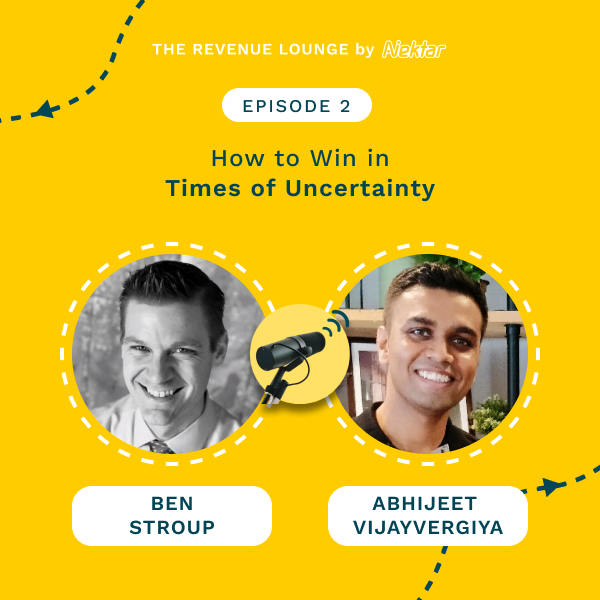
Ep #2: How to Win in Times of Uncertainty
Listen Now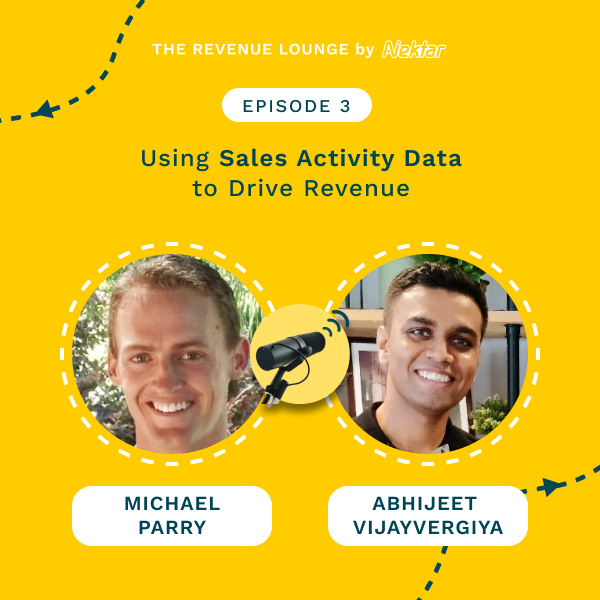
Ep #3: Using Activity Data to Drive Sales Productivity
Listen Now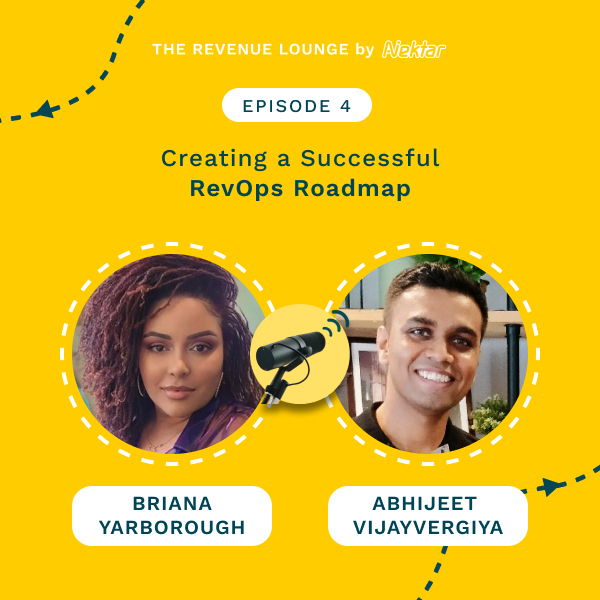
Ep #4: Creating a Successful RevOps Roadmap
Listen Now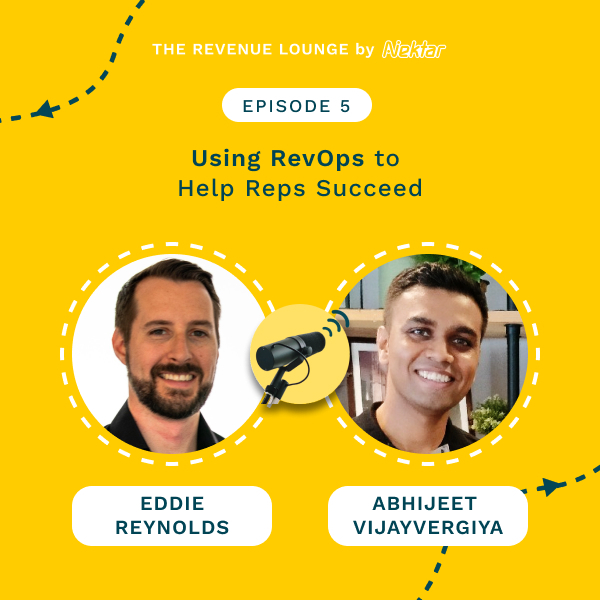
Ep #5: Using RevOps to Help Reps Succeed
Listen Now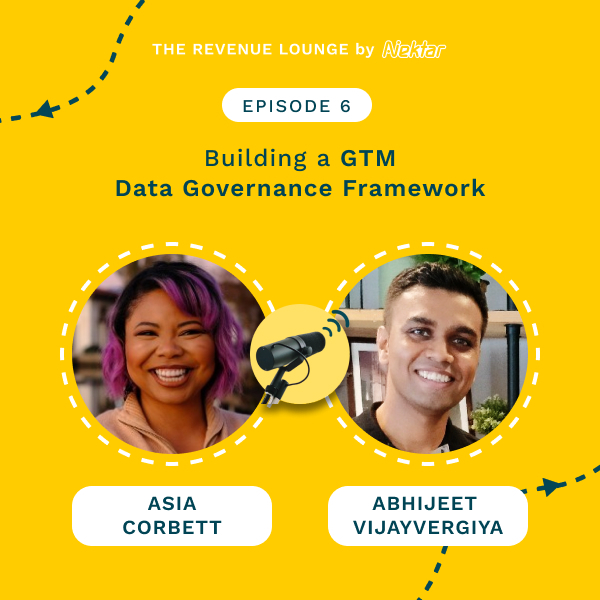
Ep #6: Building a GTM Data Governance Framework
Listen Now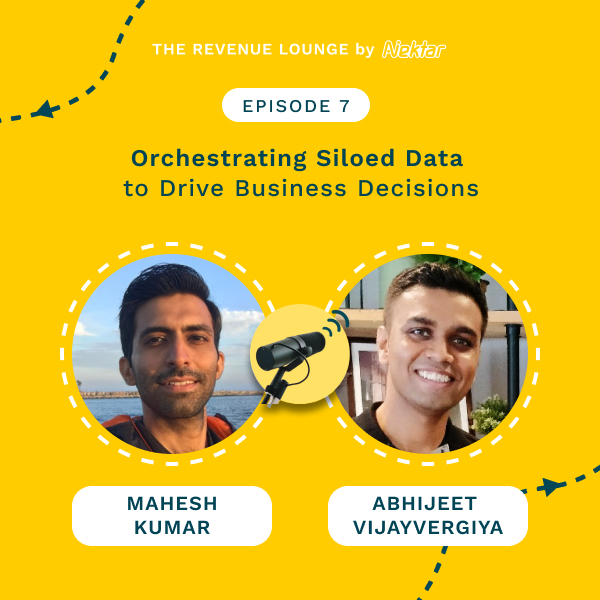
Ep #7: Orchestrating Siloed Data to Drive Business Decisions
Listen Now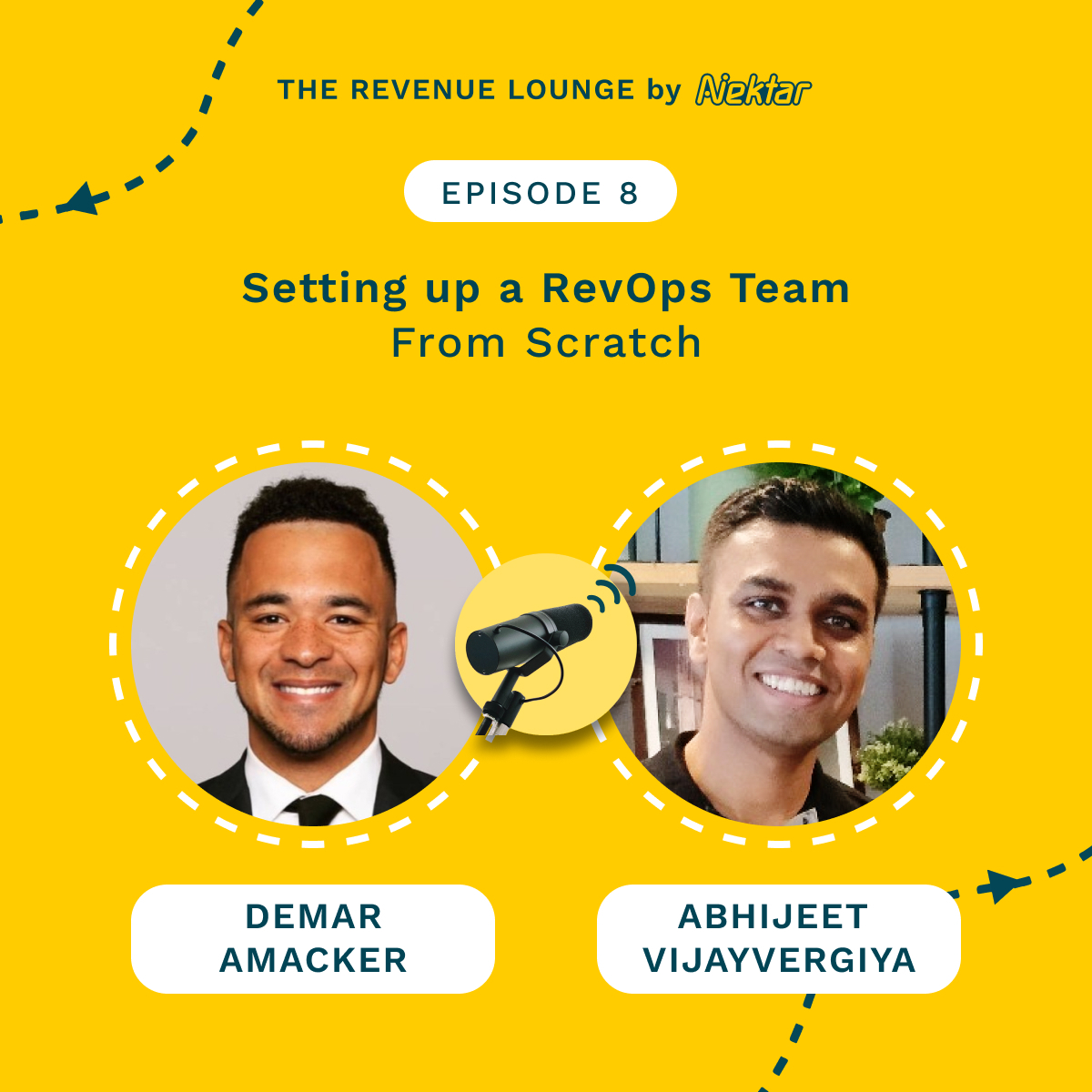
Ep #8: Setting Up a RevOps Team From Scratch
Listen Now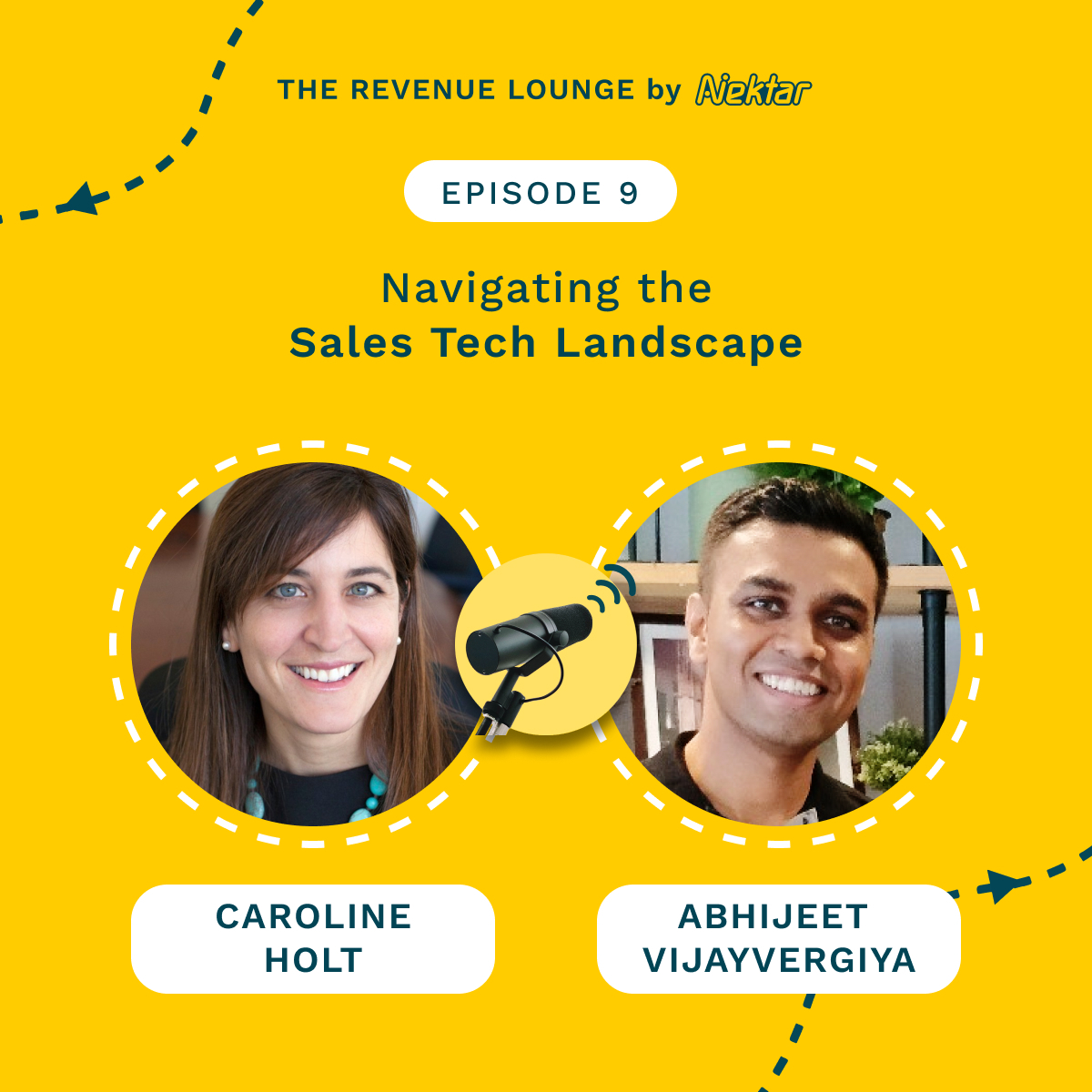
Ep #9: Navigating the Sales Tech Landscape
Listen Now